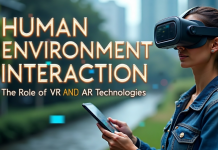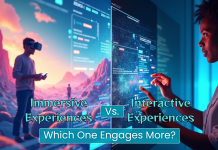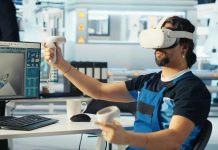Virtual Reality (VR) is one of the most promising technologies of recent years. With its application to health and fitness, I found my Ikigai, the Japanese concept of a motivational force. It’s truly the future of VR fitness.
I became co-founder and CEO of VRWorkout, a VR fitness game that allows you to work out with family, friends, or strangers around the world. It holds a patent on “passthrough” technology that creates a mixed reality fitness space. This technology gives players a presence in their real world while they are fully engaged in the game.
Key Takeaways
- The future of VR fitness combines immersive technology with health solutions, addressing time and space limitations.
- VRWorkout enables workouts with friends or strangers, adapting to individual fitness levels in an engaging environment.
- Studies show VR fitness boosts physical activity and improves mental health, making exercise enjoyable and accessible for all.
- Challenges remain, such as equipment costs and the need for high-quality content, but solutions are being developed to overcome them.
- As VR fitness evolves, it promises to be a mainstream answer to increasing physical inactivity and enhancing overall health.
Table of Contents
- VRWorkout: Overcoming Time and Space Limitations for Health and Fitness
- VR Fitness: Boosting Physical and Mental Health with Immersive Workouts
- Breaking Down Barriers: How VR Fitness is Making Exercise More Inclusive and Effective
- Overcoming Challenges: The Potential and Hurdles of VR Fitness for a Healthier Future
- Final Thoughts
VRWorkout: Overcoming Time and Space Limitations for Health and Fitness
VRWorkout helps overcome the limitations of time and space, making it possible to work out at home or even on the go. We see VR fitness as the next driving force in health tech to address the sedentary lifestyle. Just like using a mini fitness trampoline for effective at-home cardio, VRWorkout offers an engaging alternative to traditional workouts in limited spaces. Similarly, a virtual cycling app now lets users ride real-world routes from home. This blends immersive tech with cardio training in a way that’s both motivating and efficient. According to a recent study in the European Heart Journal, you can get all the exercise you need in just 8 minutes a day if you work out a little harder. That is exactly what we offer. This is the future of VR fitness.
A typical user scenario is that you are sitting in front of your laptop for 8 hours or more, working remotely from home. Your friend sends you a message asking you to meet for your daily VRWorkout session. You meet in the VRWorkout game, which recognizes your fitness level and adapts to your improvements.
VR Fitness: Boosting Physical and Mental Health with Immersive Workouts
A single workout will increase your serotonin and dopamine levels and improve your focus and reaction time. You’ll get back to your work on your laptop feeling refreshed and boosted with confidence. This is because you did something great for yourself while having fun.
Aerobic and weight-lifting exercises have been identified as the most important to improve your health and prevent cardiovascular and neurological diseases for the long run. To deliver this in the immersive, gamified world of VR fitness, our solution works without controllers. This allows free hand movement and the use of body weight or even the addition of weights and equipment.
Furthermore, the future of VR fitness also has the potential to address mental health challenges such as anxiety and depression. Exercise has been shown to have positive effects on mental health. The immersive nature of VR fitness can help provide a distraction from negative thoughts and feelings, providing a sense of accomplishment and self-efficacy.
Breaking Down Barriers: How VR Fitness is Making Exercise More Inclusive and Effective
Additionally, VR fitness can help make fitness more accessible and inclusive. People with disabilities or mobility issues often face barriers when it comes to traditional forms of exercise. However, VR fitness can provide a more inclusive and accessible environment for all. In fact, VR fitness can even provide rehabilitation and physical therapy exercises in a safe and controlled environment.
While VR fitness is still a relatively new concept, there have been several studies that have shown its effectiveness in promoting physical activity and improving health outcomes. For example, a study published in the Journal of Medical Internet Research found that participants who used VR fitness experienced significant improvements in physical activity levels, body composition, and cardiovascular health. This was compared to those who did not use VR fitness.
In addition, the study also found that participants reported high levels of enjoyment and satisfaction with the VR fitness program. This is a key factor in adherence and long-term success.
Overcoming Challenges: The Potential and Hurdles of VR Fitness for a Healthier Future
However, there are still challenges that need to be addressed in order to fully realize the potential of VR fitness. One of the biggest challenges is the cost of equipment, which can be a barrier for many people. While the cost of VR equipment has decreased in recent years, it is still not accessible to everyone.
Another challenge was the need for high-quality content that was both engaging and effective. As with any form of exercise, the success of VR fitness depends on the quality of the workout and the level of engagement and motivation it provides. I believe we can overcome this challenge with our solution. It provides high-quality content that is both fun and effective. Now we are focusing on fitness challenges for our users with the help of virtual personal trainers and fitness influencers. You meet them in the extended reality.
Lastly, concerns about the safety and efficacy of VR fitness for certain populations, such as older adults or people with disabilities, need to be addressed. While there is evidence that VR fitness can be effective for these populations, more research is needed to ensure that it is safe and effective for everyone.
Final Thoughts
In conclusion, the intersection of technology and health has the potential to revolutionize the way we approach fitness and promote a healthy lifestyle. VR fitness is a promising technology that can address many of the challenges of traditional exercise. It provides an engaging, fully interactive experience to improve both physical and mental health.
The future of VR fitness is guaranteed. We are excited to continue to innovate and explore the potential of this technology to promote health and well-being for all. As VR fitness becomes more accessible and affordable, it has the potential to become a mainstream solution. It can address the global issue of physical inactivity and improve the health outcomes of millions of people.











